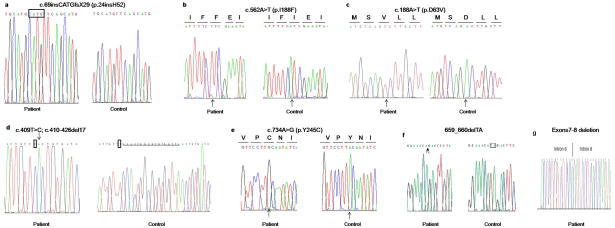Figure 3.
a) Affected individuals in families A and B had a common homozygous mutation designated, c.69insCATGfsX29 in the LPAR6 gene. b) Affected individuals in families C, D and E had a common homozygous mutation designated, p.I188F in the LPAR6 gene. c) Affected individuals in family F had a homozygous mutation designated, p.D63V in the LPAR6 gene. d) Affected individuals in family G had a homozygous mutation designated c.409T>C; c.410-426del17 in the LPAR6 gene. e) Affected individuals in family H had the homozygous mutation p.Y245C in the LPAR6 gene. f) Affected individuals in family I had the homozygous mutation c.659_660delTA in the LIPH gene. g) Affected individuals in family J had homozygous deletion of exons 7 and 8 in LIPH gene.

